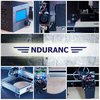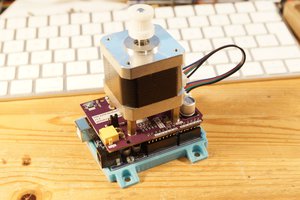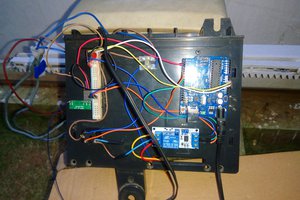ICStation Team introduce you this stepper motor control system based on ICStation UNO compatible with Arduino. It uses ULN2003 chip to drive. The working voltage is DC5V. It is widely used on ATM machine, inkjet printer,cutting plotter, fax machine,spraying equipment, medical instruments and equipments, PC peripheral, and USB Mass Storage ,precise instrument,industrial control system,office automation,robot areas,etc.
Functions
1.When start up, the stepper motor will rotate in the clockwise direction, at the same time the1602 LCD will display the stepping rate and rotating direction.
2.When you press the key1, the stepper motor will rotate in the counter-clockwise direction.
3.When you turn the potentiometer to the left or to the right, you can adjust the stepping rate of the stepper motor. At the same tine the 1602 LCD will display the current speed.
Code for your reference:
http://www.icstation.com/newsletter/eMarketing/Stepper_Motor_Code.txt
Step 1: Components List

1.ICStation ATMEGA328 UNO V3.0 R3 Board Compatible Arduino
2.1602A HD44780 Character LCD Display Module
3.5V 4 Phase 5 Line 28BYJ-48 5VDC Stepper Motor
4.50K Ohm B50K Knurled Shaft Linear Rotary Taper Potentiometer
5.ULN2003AN DIP-16 TI Darlington Transistor Array
6.Trim Pot Resistor Potentiometer
7.830 Point Solderless PCB Bread Board MB-102 Test DIY
8.12X12X5mm Tact Switches 4 Legs
9.Bread Board Jump Line Jumper Wire
10. Dupont 20cm Color Cable Line
11.+5V DC power supply
Step 2: Schematic Diagram

Working Principle:
To change the rotating speed of the stepper motor by changing the input frequency of pulse signal. And to realize the motor rotating in the clockeise direction and counter-clockwise direction by controlling the transform sequence of the pulse signal.
Step 3: Overall hardware connected diagram

Step 4: Plug into the power supply wires and place the components

Step 5: Connect the LCD1602

Step 6: Connect the stepper motor

Step 7: Connect the signal end and power supply end

Connect the signal end of the components and the cathode and anode of the power supply to the ICStation UNO board compatible with Arduino and common port of power supply.
Step 8: The experimental effect after starting up the power supply

 icstation
icstation

 robotlab
robotlab
 Jan Neumann
Jan Neumann
 Lasith Ishan
Lasith Ishan
 Matthew Potter
Matthew Potter
MakeBlock XY plotter kit transformation
MakeBlock XY plotter is really good thing to use for engraving and laser cutting because
it has bigger sizes comparing to DIY kit. 31 X 39 cm (is quite a lot)
As far as we know there is a laser kit for MakeBlock but we did not try it. If anyone has
an experience, please share with us!